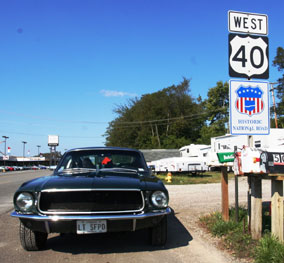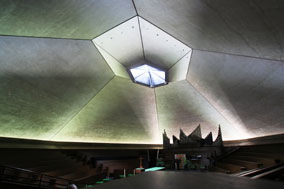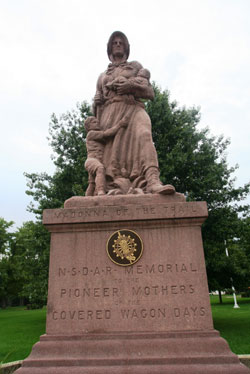|
Driving the National Road by Llewellyn M. Toulmin
The National Road was the nation’s first Federal highway. It was authorized by President Thomas Jefferson in 1806, and construction continued through 1839. It was a key route in opening up our country, yet most Americans and even most Marylanders have never heard of it, although it starts in Cumberland, Maryland. My wife and I decided to drive it in our classic 1968 “Bullitt” Mustang, as the first leg on a cross-country motoring adventure.
We got up early and headed out from Silver Spring, driving north on Georgia Avenue until we hit Interstate 40, then turning west. Arriving in Cumberland, we began our adventure, getting on US Route 40 going west out of town. Immediately we were struck by the difference between driving on the interstate and driving on the National Road. The National Road is usually only two lanes, it is quieter; it goes through the middle of towns; it winds around the contours of hills rather than cutting through them; and it has few big trucks, which are the plague of the modern interstates. Winding though the hills of western Maryland, we stopped in Grantsville at the famous Artisan Village, and saw some fabulous feather and bird carvings done by master sculptor Gary Yoder. His wooden feathers and birds looked more lifelike than real birds! Entering Pennsylvania, we decided to try to find the high point of the state, just a few miles north of US Route 40. Following directions from the Highpointers Club (www.highpointers.org), we were able to drive almost up to the highest point in the state, atop Mount Davis at 3213 feet. Climbing to the top of the metal observation tower, we found a terrific 30-mile view in all directions. Arriving in Ohio, we stopped at the fascinating Hopalong Cassidy Museum in Cambridge. The museum is dedicated to the memory of William L. Boyd (1895-1972) and the character Hopalong Cassidy he portrayed on TV and in 54 films. There we learned that Boyd was married five times and was asked to play the part of Moses in The Ten Commandments, but amazingly, turned down the part and let it go to Charlton Heston. Boyd was afraid that the public’s intense identification of him as “Hoppie” would spoil the movie’s effect. Thanks for being so concerned, Hoppie—good call! Crossing into Indiana, we decided to detour to find the high point of that state, also. The Highpointers directions guided us to a hidden grove of trees off a rural road. The site actually looked lower than a nearby field, but a marker assured us we were in the right spot. It had a nice picnic table and a post box with a book of names of previous Highpointers and their comments. Most Highpointers hike to state highpoints—I think we have invented a new sport: classic car Highpointing! At Richmond, Indiana, we had an excellent cafeteria meal at the MCL Cafeteria, recommended by Michael and Jane Stern of www.roadfood.com and Gourmet Magazine. Their website is our constant companion on our travels around the US. Good 1950s-style cafeterias are rare on the east coast, so it was great to get to the country’s heartland and fill up on good vegetables and home style cooking.
In central Illinois, we found an old courthouse where Abe Lincoln himself practiced law. He road a horseback circuit around the state, ate terrible food, met his clients under a tree, then argued his cases in a tiny courtroom, providing entertainment for the townspeople. But this tough schooling prepared him for debating and politicking at the national level. Sometimes we complained about our rather noisy 1968 Mustang, but we were very grateful for its 65 miles per hour and 335 horsepower, instead of 5 miles per hour and only one horsepower! And amazingly, our steel steed never broke down once on the National Road, in 824 miles—I’m sure Abe’s horse couldn’t match that record. Finally, at the end of the National Road in Vandalia, Illinois, we met one of the guardian angels of the highway, a Madonna of the Trails. Twelve identical statues were erected by the Daughters of the American Revolution in 1928 to honor the major roads and trails that created this country. The most easterly one is in Rockville, Maryland, right beside the Rockville Post Office. The Madonna in Vandalia marks the end of the National Road, one of the great, little-known highways of the American past—and a delightful destination for the present. Lew Toulmin lives in Silver Spring. He drove his 1968 “Bullitt” Mustang cross-country once before in the Great Race of 2005, and has rallied it for over 2000 miles with the Northeast Rally Club. In future columns he will describe his 4000-mile odyssey on Route 66. For more information on the National Road see www.mdhistoricnationalroad.com. Close this window |


